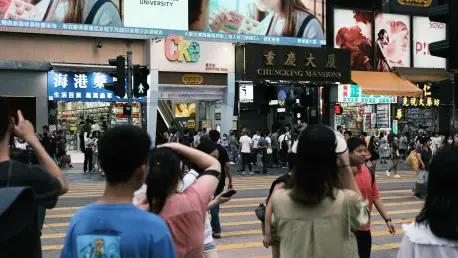Imagine a bustling city where shopping districts hum with energy, fueled by millions of visitors eager to spend after years of economic uncertainty, and Hong Kong, long celebrated as a global retail powerhouse, is witnessing just that this year with a remarkable uptick in retail sales driven by a tourism boom. This roundup dives into diverse perspectives from industry leaders, analysts, and policymakers to unpack the forces behind this resurgence. The purpose is to gather varied insights on how tourism, especially from mainland China, is shaping retail growth, what challenges persist, and what strategies can sustain this momentum. Through a collection of opinions and tips, this piece aims to offer a comprehensive view of Hong Kong’s retail landscape.
A Revival Fueled by Visitors
Hong Kong’s retail sector has marked a significant turnaround with three consecutive months of sales growth, a clear signal of economic recovery. Industry observers note that the city’s identity as a shopping haven is being reaffirmed, with visitor numbers climbing steadily. A particular focus has been on the role of mainland Chinese tourists, whose presence has revitalized key commercial areas.
This revival is seen as a critical step in overcoming past downturns that once dimmed the city’s economic outlook. Analysts highlight that the retail sector’s health is intertwined with tourism, pointing to specific areas like luxury goods as major beneficiaries. Yet, there’s curiosity about whether this growth can endure amid global economic headwinds, setting the stage for deeper exploration of opinions.
The consensus among stakeholders is that while the signs are promising, the recovery’s depth varies across different retail segments. Some sectors are soaring, while others lag, prompting discussions on how to balance these disparities. This roundup will explore these dynamics through a range of expert views and practical insights.
Insights from Multiple Perspectives
Tourism as the Growth Engine
A common viewpoint among industry leaders is that the surge in tourist arrivals, hitting 4.39 million in July alone with a 12% increase from last year, is the heartbeat of retail success. With 3.51 million of these visitors hailing from mainland China, their spending has pushed retail sales to HK$29.7 billion, reflecting a 1.8% year-on-year rise. This data underscores the undeniable impact of cross-border travel on local commerce.
However, some market analysts caution that tourist spending isn’t as robust as the numbers suggest. Global economic uncertainties have led to more conservative purchasing habits, with many visitors prioritizing essentials over discretionary items. This tempered enthusiasm is a concern for retailers banking on high-value transactions to drive profits.
A contrasting opinion from tourism board representatives emphasizes optimism, noting that the sheer volume of arrivals compensates for cautious spending. They argue that sustained growth in visitor numbers could gradually rebuild confidence in lavish purchases. This divergence in views highlights the need for retailers to adapt to fluctuating consumer behaviors while capitalizing on foot traffic.
Sector-Specific Wins and Losses
Retail consultants point out stark differences in performance across categories, with luxury goods leading the charge. Sales of jewelry, watches, and high-end gifts spiked by 9.4% in July, driven by affluent tourists seeking premium products. This trend is viewed as a strong indicator of renewed interest in upscale shopping experiences unique to Hong Kong.
On the flip side, clothing and footwear retailers report minimal gains, with a mere 0.1% sales increase during the same period. Some business owners in this segment express frustration over inconsistent consumer confidence, noting that budget-conscious shoppers are holding back. This disparity sparks debate on whether focusing on luxury markets alone is sustainable.
A third perspective from economic think tanks suggests diversifying product offerings to appeal to a broader audience, including local buyers. They advocate for mid-range and experiential retail options to balance reliance on high-end sales. Such strategies, they argue, could stabilize growth across varied consumer segments, a tip many retailers are beginning to consider.
Government Initiatives Under Scrutiny
Policymakers and business associations largely agree that government efforts, such as relaxed travel policies and hosting major events, have been instrumental in boosting visitor numbers. These measures are credited with enhancing Hong Kong’s appeal as a gateway for mainland Chinese tourists, directly impacting retail activity in shopping hubs.
Yet, some economic advisors express skepticism about over-dependence on tourism-driven policies. They warn that without deeper structural reforms, such as incentives for local spending or business innovation, the sector remains vulnerable to external shocks. This critical stance urges a broader approach to ensure long-term stability beyond event-based spikes.
A differing angle comes from retail federations, which praise the strategic positioning of Hong Kong as a regional shopping destination. They believe that sustained policy support, if paired with private sector collaboration, can solidify gains made this year. This blend of optimism and caution reflects a nuanced discussion on governmental roles in retail recovery.
Economic Challenges on the Horizon
Despite monthly upticks, a broader concern among financial analysts is the 2.6% decline in retail sales over the first seven months of this year. This statistic serves as a sobering reminder that recovery is far from complete, with lingering effects of earlier economic slowdowns still evident. The fragility of consumer sentiment is a recurring topic in these circles.
Some industry watchers draw comparisons with previous recovery phases, suggesting that cautious spending on non-essentials by tourists could stall momentum. They stress the importance of understanding these behavioral shifts to tailor marketing efforts. Their analysis points to a need for agility in responding to global economic trends affecting travel and expenditure.
A more hopeful take from retail strategists focuses on potential opportunities within these challenges. They propose that adapting to conservative spending by emphasizing value-driven promotions or unique in-store experiences could open new revenue streams. This perspective encourages businesses to view constraints as catalysts for creative problem-solving.
Strategies for Retailers to Stay Competitive
Retail experts collectively advise tailoring product lines to match the cautious spending patterns observed among tourists and locals alike. Offering affordable luxury or bundled deals could attract a wider customer base without alienating premium buyers. This practical tip is seen as a way to bridge gaps in current market demand.
Another frequently mentioned strategy is leveraging government-backed events to boost visibility and sales. Business consultants suggest partnering with tourism campaigns or cultural festivals to draw crowds, creating synergies between public initiatives and private enterprises. Such collaborations are viewed as low-risk ways to enhance footfall.
Finally, a strong push toward digital transformation emerges from tech-savvy analysts. Enhancing online presence through targeted e-commerce platforms or social media engagement is recommended to capture both local and international markets. This forward-thinking approach is deemed essential for staying competitive in an ever-evolving retail landscape.
Reflecting on the Path Taken
Looking back, the discussions around Hong Kong’s retail sector revealed a complex tapestry of growth and caution. The consensus was clear that tourism, particularly from mainland China, played a pivotal role in driving sales, with luxury goods standing out as a key winner. However, the persistent year-to-date sales decline served as a reminder of underlying vulnerabilities that needed addressing.
Differing opinions on government policies and consumer behavior enriched the dialogue, offering a spectrum of strategies from diversification to digital innovation. These insights underscored the importance of adaptability in navigating economic uncertainties. Retailers who embraced varied approaches appeared better positioned to weather challenges.
Moving forward, businesses should prioritize building resilience through targeted offerings and strategic partnerships. Exploring niche markets or investing in customer experience enhancements could provide a competitive edge. As Hong Kong’s retail sector continues to evolve, staying attuned to global trends and local needs will be crucial for sustained success.









